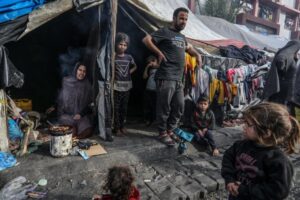Palestinians in Gaza’s displacement camps face rampant disease due to destroyed infrastructure

A Palestinian family in a makeshift tent in Rafah, 28 March 2024
Tareq S Hajjaj reports in Mondoweiss on 3 May 2024:
It is an unexpectedly hot day in Rafah City. A tent catches on fire in the middle of the camp. The fire spreads quickly, spreading to other tents with the wind. People look on in astonishment or run between the tents in an attempt to put it out. They scream loudly and call for help, but the fire keeps spreading.
Civil Defense crews near the Tal al-Sultan area in Rafah arrive on the scene and put out the fire, but not before it had spread to a few other neighboring tents. A few meters away, Samih al-Nahhala, 48, explains how his tent had been the first to go up in flames.
The minute he and his family had sensed danger, they jumped out and were able to avoid the sudden conflagration, Nahhala says, but they lost all their belongings, or at least all that they owned that had not already been lost since their displacement. “Using the tent for everything in one place leads to many risks,” al-Nahhala tells Mondoweiss. “Including this fire that broke out as a result of my family’s use of cooking tools near the tent. That’s what caused it.” Behind Samih are the charred remains of a row of several tents. “These four meters house more than a single family,” he says.
Because there was no space between Samih’s tent and that of his neighbors’ when the fire broke out, the spread of the flames through cloth and nylon was something akin to a wildfire.
**** **** ****
Flooding sewage passes under the tents of the displaced and on the sidewalks and roads of Rafah. Piles of garbage litter the entrances to school shelters and around displacement camps, attracting flies and insects, which fill tents. Children play barefoot in the sand, mixing with mud, water, and sewage, and transporting germs and microbes to their tightly packed living quarters. In the heat wave, the nylon-covered tents trap in more heat and turn shelters into ovens.
